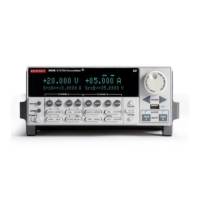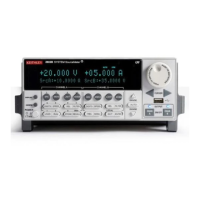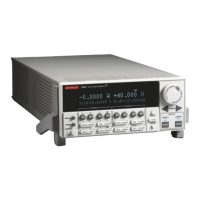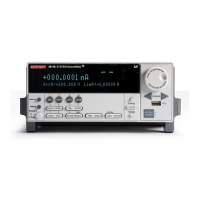19-12 Return to Section Topics 2600AS-901-01 Rev. B / September 2008
Section 19: Remote Commands Series 2600A System SourceMeter® Instruments Reference Manual
• Whitespace in a function is not required. The function to set digital I/O line 3 low can be sent
with or without whitespaces as follows:
digio.writebit(3,0) -- Whitespaces NOT used in string.
digio.writebit (3, 0) -- Whitespaces used in string.
• Some commands require multiple parameters. Multiple parameters must be separated by
commas (,), as shown above for the
digio.writebit function.
TSP-Link nodes
Each instrument or enclosure attached to the TSP-Link bus must be uniquely identified. This
identification is called a TSP-Link node number, and the enclosures are called nodes. Each node
must be assigned a unique node number.
From a test script program point of view, nodes look like tables. There is one global table named
node that contains all the actual nodes that are themselves tables. An individual node is accessed
as
node[N] where N is the node number assigned to the node. Each node has certain attributes
that can be accessed as elements of its associated table. These are listed as follows:
• model The product model number string of the node.
• revision The product revision string of the node.
• serialno The product serial number string of the node.
There is also an entry for each logical instrument on the node (see Logical instruments).
It is not necessary to know the node number of the node running a script. The variable localnode
is an alias for the node entry the script is running on. For example, if a script is running on node 5,
the global variable
localnode will be an alias for node[5].
Logical instruments
You would normally refer to all instrumentation within one enclosure or node as a single
instrument. For TSP and the Instrument Control Library (ICL), it is useful to think of individual
SMUs as instruments. To avoid confusion, SMUs and other subdivisions of the instrumentation
within an enclosure will be referred to as “logical instruments.”
Each logical instrument is given a unique identifier in a system. These identifiers are used as part
of all ICL function calls that control a given logical instrument. The Series 2600A SMU has the
following logical instruments in each enclosure:
Logical instruments also look like TSP tables. Each logical instrument has an element for each
command that it supports. These commands are documented in this section. Note that
smua and
smub support the same command set and are documented jointly as smuX.
On any given node, the logical instrument identifiers from that node are also global variables. They
can be accessed as elements of the node they belong or directly if running on that node. For
example, to execute the
measure.v command on smua on node[5], one could use
node[5].smua.measure.v(). If the command is being issued (executed) on node[5], then
smua.measure.v() is sufficient. Only be concerned with node numbers when controlling multiple
units via the TSP-Link.
beeper errorqueue serial timer
dataqueue eventlog smua trigger
digio gpib smub tsplink
display lan status tspnet

